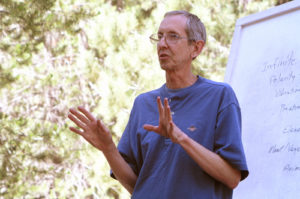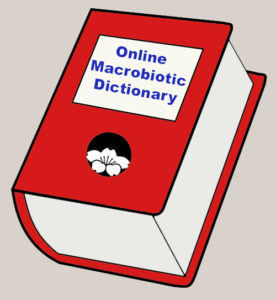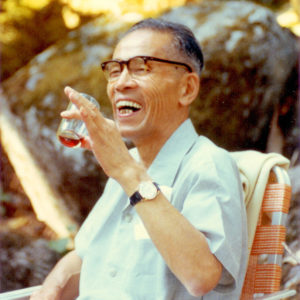
Completed Entries
The use of specific techniques for optimal food choices, preparation, and consumption based on combining healthy traditional foods, including whole grains and their products, fresh vegetables, beans, fruit, nuts, seeds, pickles, fermented foods, herbs, seasonings, sea vegetables, and teas. Each person discovers the best foods for her or him based on macrobiotic principles. Thus, the term “the macrobiotic diet” is inaccurate; there are as many different diets as there are people. Many people thrive being vegan and other people choose to include some animal food.
a system of holistic principles and dynamic practices that guides choices in nutrition, activity, and lifestyle for physical, emotional, mental, social, and environmental health.
– macrobiotic, adj., such as macrobiotic philosophy or macrobiotic dietary approach.
Origin: from Ancient Greek: Makros (large or long), Bios (life or way of living), and Thiké (technique or art of). First used by German physician Christoph von Hufeland (1762-1836) in his book title translated in English as: Macrobiotics or the Art of Prolonging Human Life.
Ohsawa’s charming name for the unifying principle of yin-yang providing a method for making daily decisions and for realizing one’s connection with Oneness (Infinity).
Magnesium is a yang alkaline-forming mineral that is essential to human nutrition. Magnesium activates enzymes in carbohydrate metabolism, helps maintain normal nerve and muscle function, aids in maintaining strong bones, keeps one’s heartbeat steady, and is necessary for the production of blood, and protein, and energy. Signs the body is low in magnesium include muscle twitches and cramps, fatigue, weakness, numbness or tingling, and irregular heartbeat. Magnesium deficiency contributes to illnesses such as asthma, high blood pressure, osteoporosis, and mental disorders. Vegetal foods with high amounts of magnesium include sea vegetables, especially dulse; dried beans, especially soybeans and lentils; leafy greens; whole grains, especially quinoa and whole wheat; almonds and other nuts, and miso. Animal foods with medium amounts of magnesium include salmon, mackerel, tuna, chicken, and turkey.
A form of external treatment that involves lightly rubbing an area of the body with a therapeutic substance or in a helpful way.
See Cautionary note.
Apple juice massage: Juice from grated apple massaged into the scalp to relieve headaches.
Chlorophyll juice massage: Juice from any green vegetable leaves used as a massage on any area of yang skin disease such as dry eczema.
Daikon juice: Juice from grated daikon massaged into the scalp to relieve headaches.
Eggplant sulfur massage: Eggplant soaked in sulfur and rubbing alcohol and used as a massage to remove red birthmarks.
Ginger sesame oil massage: Juice from grated ginger and sesame oil used as a massage for numerous symptoms from pain to skin diseases. It is also used to help correct curvature of the spine.
Pine needle scalp massage: Bundled pine needles used to stimulate the scalp to promote hair growth.
Rice bran massage: Heated rice bran wrapped in cotton or placed in a cotton bag and used as a massage for severe frostbite.
Stomach massage: The hands used to massage the stomach and intestinal area to relieve constipation or diverticular pain.
Vinegar massage: Heated vinegar massaged into any area with skin discoloration.
Crescent-shaped wedge cut, used for round vegetables.
Latin for “my fault.” Ohsawa taught that all diseases are some variation of one’s loss of balance—physically, mentally, or spiritually. Thus, he felt the first step in recovery is to search for and recognize one’s own actions that contributed to the disease. While it can be useful to consider one’s own actions that may lead to disease, factors outside oneself may contribute as well.
In macrobiotic practice, red meats are avoided unless there is a specific curative need for a short period of time. While other animal foods are included by some people for pleasure or as a temporary curative on occasion, these are usually limited to seafood, poultry, cheese, and ghee (clarified butter). The macrobiotic view is that there are plenty of vegetable sources of protein and fat. And, today there are vegan “meat” and dairy-free alternatives for occasional use. Before using any of these products, check ingredients for added sugar, chemicals, or preservatives. See also Animal foods.
Ohsawa presented seven levels of medicine that evolve in the following order:
- Symptomatic medicine is treatment to remove symptoms through artificial means such as an injection or a pill. This level also includes folk medicine in which health practices arise from cultural tradition and native remedies such as various foods. “Western medicine believes it has succeeded when it has eliminated symptoms or immediate consequences; it is not concerned with causes.” Cancer and the Philosophy of the Far East, 30.
- Prophylactic medicine is preventive medicine through the promotion of physical and mental health and the avoidance of known toxins such as carcinogens.
- Art of health is the study of ways and means to acquire and maintain physical health. “All disease, unhappiness, crime, and punishment result from behavior that violates the Order of the Universe. The cure is, therefore, infinitely simple. Merely stop violating that order and allow Nature to do her miraculous work.” Zen Macrobiotics, 26.
- Macrobiotic medicine is the art of rejuvenation and longevity. Macrobiotics provides a healthy way to live. Suggestions to help remedy specific diseases are tailored to each individual case and are complementary to medical treatments. Macrobiotic health coaches (often referred to as counselors) may be consulted if and when needed. In all cases, the macrobiotic approach is to look for the underlying cause of the illness and to “treat” that rather than merely working on the symptoms of the disease.
- Socio-moral and educational medicine establishes health, freedom, and justice in society. “Far Eastern medicine, originating 5,000 years ago, was not a medicine of symptoms, but a fundamental method of cure that is based on natural causes. This is why it was also a method of health, longevity, and happiness. It was not concerned with the disappearance of symptoms, but it was an educative medicine, which had as its end the development of man’s judgment.” Practical Guide to Far-Eastern Macrobiotic Medicine, 198.
- Philosophical medicine is directed to thought, mind, and judgment. From a macrobiotic perspective, disease is seen as a divine warning. “Healing power is in our minds. The material for opening our minds and for healing disease, however, is food, the qualities of which we distinguish through our minds. If we cannot clear our minds, we cannot distinguish correct food. Healing power is in the mind. Sickness is given to us so that we may discover this mind.” Essential Ohsawa, 84.
- “Supreme medicine, which is educational, biological, physiological, and a dialectical technique, aims to permit the ailing person to discover all by himself the constitution of life and the world. It cures, decidedly, not only all the disease of the present and future, but every misfortune, too.” Philosophy of Oriental Medicine, 15.
Mineral-rich root of wakame seaweed.
A Chinese system of pathways in the body along which vital energy is thought to flow. These pathways are used in acupuncture and acupressure.
The processes that produce, maintain, and destroy material substances in the body, thus making energy available. These processes require water; dehydration slows down metabolism resulting in a lack of energy.
Minced cutting style for vegetables.
The macrobiotic view is that cow’s milk is mainly for baby cows; milk and other dairy products are only consumed occasionally in small amounts as a pleasure food, if at all. Plant-based alternatives to cow’s milk include rice milk, almond milk, and soy milk. These are used from time to time as beverages and in recipes that call for cow’s milk.
The macrobiotic belief is that mother’s milk is the best food for babies. Thus, breastfeeding is preferred in all cases unless there is some problem preventing it. If breastfeeding is not possible, the macrobiotic alternative is to use kokkoh (grain milk) or another substitute other than cow’s milk.
All minerals work together and are essential for maintaining health. They help the body keep one’s bones, muscles, heart, nerve function, and brain working properly, and are important for making enzymes and hormones and for building strong bones and teeth, blood, skin, hair, and muscles. They also help turn food into energy.
Minerals are divided into two groups. The essential macrominerals (large amount needed) are calcium, chloride, magnesium, phosphorus, potassium, sodium, and sulfur. The essential trace minerals (small amount needed) are chromium, copper, fluoride, iodine, iron, manganese, molybdenum, selenium, and zinc. Of the macrominerals, calcium, magnesium, potassium, and iron are the hardest to obtain in adequate amounts from one’s diet. These four minerals along with sodium are alkaline forming, the rest are acid forming.
A macrobiotic dietary approach contains ample amounts of minerals, especially when sea salt and sea vegetables are used regularly. As with all things, moderation is key as a deficiency can lead to weak bones, fatigue, a decreased immune system, or other problems while overabundance can cause hardness or tightness in the body. See the entries for each mineral for specific information on a deficiency or overabundance of that mineral. Mineral supplements, if used, need to be taken with care and caution because a deficiency or overabundance of any specific mineral affects the proper functioning of all other minerals.
Amount of nutrients established by the United States Food and Drug Administration required daily for health and to prevent a deficiency disease. The figures mostly come from experiments on animals and include an added amount for safety. Older macrobiotic writings refer to these figures. Newer writings use recommended dietary allowance (RDA) amounts from the Institute of Medicine (IOM) of the National Academy of Sciences. See also Recommended dietary allowance (RDA).
Sweet rice wine used in Japanese cooking.
Basic Japanese staple made from fermented soybeans, sea salt, and barley or another grain. Often used as a flavoring agent in soups. Miso is useful for people who have heart conditions, diabetes, rheumatism, polio, asthma, tuberculosis, and skin problems.
Barley, soybean, or rice miso used as a plaster for bleeding from cuts or for swelling.
See Cautionary note.
Pounded, steamed sweet rice made into glutinous cakes, traditionally served in Japan at New Year’s.
The theory that there is only one entity or principle that is the basis of reality. This Oneness produces all things through the interactions of connected yet opposing forces or tendencies.
See Nonduality.
Whole fermented soybeans, just before squeezing for soy sauce.
The macrobiotic belief is that mother’s milk is the best food for babies. Thus, breastfeeding is preferred in all cases unless there is some problem preventing it. If breastfeeding is not possible, the macrobiotic alternative is to use kokkoh (grain milk) or another substitute other than cow’s milk.
A process in which dried mugwort is place on the skin and heated (burned) to stimulate energy.
Bean sprouts.
Created by George Ohsawa, mu tea is a full-bodied blend of from nine to sixteen herbs. The variety with sixteen herbs is useful for relieving menstrual cramps and fatigue, and is good for weak stomachs and mucus-thick coughs.
Barley.
A tea made from roasted unhulled barley and water.
A plant that grows in early spring. Mugwort is good in cases of anemia (since it is high in iron) and for ridding the body of parasites. It can be slightly bitter; gather only the young leaves as they are sweetest. Pick them in the spring and dry in a shady place. Mugwort will keep for the rest of the year in a glass jar. Soak the dried mugwort before using it.
Brown rice mochi with mugwort added during processing.
Dried mustard powder, white flour, and warm water made into a paste-like consistency and mainly used to stimulate circulation and dissolve stagnation.
See Cautionary note.
Mustard powder mixed with warm water and used for pain from dental caries.
See Cautionary note.
Steamed dishes.
Water from boiled mustard powder used as a full bath to improve circulation.
See Cautionary note.
Water from boiled mustard powder used as a foot bath to improve circulation.
See Cautionary note.
Hot mustard powder used as a hip bath for diarrhea or stomachaches.
See Cautionary note.
Seaweed or other food that has been tied in a knot. Rice balls are also called musubi.
Projected Entries
Macrobiotic summer camp
Macrobiotic treatment suggestions
Macrobiotic, The
Macrobiotics Today
Maki sushi
Main foods
Maison Ignoramus
Majority
Maple syrup
Marinate
Masa
Materialists
Maternal essence
Meaning (of life)
Meditation
Memory
Men and women
Mendelsohn, Dr. Robert
Meningitis
Menstrual irregularity
Mental illness (health)
Menu, sample
Methionine
Method
Meridians
Middle ear infections
Migraine
Millet
Miracle of life
Miso Soup
Misogi ceremony
Moderation
Money
Monosaccharide
Monosodium glutamate
Monosodium glutamic acid
Moon, Jymm
Morishita, Dr. Keiichi
Morning sickness
Movement
Mucus-forming
Mugi miso
Muramoto, Noboru
Musubi magazine
Myopia
Questions or Comments?




